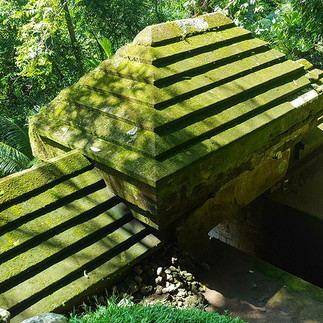Goa Garba and the Legacy of Kebo Iwa
- Shannon
- Sep 16
- 4 min read
Carved into the rugged rock face of a ravine above the banks of the sacred Pakerisan River, this ancient hermitage niche is a remarkable archaeological site that offers a glimpse into Bali’s pre Hindu past. Hidden discreetly in the quiet hamlet of Sawan Gunung, the site shelters a collection of pre Hindu megaliths, silent remnants of an era long before the arrival of Hindu-Buddhist influence on the island. These timeworn stone structures suggest that the area once held deep spiritual significance for early Balinese cultures, possibly serving as a meditation retreat or ritual space for ascetics and sages. Today, it remains one of the most important and oldest historical sites in Bali, not only for its age but also for its enduring connection to the island’s sacred geography and ancestral traditions.

It is said that Goa Garba, whose name loosely translates to “The Womb” or “Belly of the Earth”, was constructed in 1116AD by the legendary figure Kebo Iwa. Revered in Balinese folklore as a gentle giant and a protector of the island, Kebo Iwa is often described as a being of immense strength and wisdom, whose towering presence was matched only by his compassion for the people of Bali. His mythical deeds, which include constructing temples, moving mountains and performing legendary feats of engineering and endurance, have placed him firmly within the pantheon of Balinese demi-gods. Goa Garba is believed to be one of his many creations, carved into the sacred cliffs near the Pakerisan River. The cave's symbolic name and hidden location suggest that it may have served as a spiritual retreat, a place for meditation or even a site for ancient rites of rebirth and transformation, echoing the life giving and protective qualities associated with both the earth and the legendary Kebo Iwa himself.
According to legend, Kebo Iwa was born during a time of great uncertainty in Bali, when the island was plagued by natural disasters and social unrest. His birth was seen as a divine omen, a blessing from the gods to restore balance and protect the people. Though his parentage is shrouded in myth, many believe he was the son of an ordinary Balinese woman who had prayed fervently for a child, only to be granted a miracle far beyond her expectations. From the day he was born, Kebo Iwa had an insatiable appetite. His mother’s milk could not satisfy him and even as an infant, he would gesture toward her until she fed him freshly cooked rice. It took more than a village to raise this child, but the people eagerly rallied to help, believing he was a gift from the heavens. In return, Kebo Iwa became their protector. When drought and famine struck, he dug deep wells with his bare hands to irrigate the rice fields and keep the community fed. As he grew, so did his legend. Many say it was he who etched the nearby Gunung Kawi cave panels into the cliffs with nothing but his fingernails, leaving his mark, both literal and mythical, on the very stone of Bali.

The ancient site of Goa Garba - home to the enduring legacy of Kebo Iwa, Bali’s mythical giant and master carver
Many believe that Kebo Iwa honed his war skills at Goa Garba, undergoing a series of grueling trials before attaining his immense physical strength and spiritual powers. During this intense period of training, he defeated countless challengers in combat, leaving their bodies scattered across the landscape. This bloody chapter in the myth is said to be the origin of the village’s name "Sawagunung", derived from sawa, meaning “dead bodies,” and gunung, meaning “mountain.” The name serves as a grim reminder of the battles fought and the power Kebo Iwa came to wield. About halfway up the stone steps leading to Goa Garba, visitors will find a large boulder behind an iron gate. Imprinted on its surface is what is believed to be the footprint of Kebo Iwa himself, a lasting mark left by the giant during his legendary training.
The primitive stone enclosure at Goa Garba was not only a spiritual sanctuary but also served a vital role in shaping the island’s early leadership. It is said that this secluded and sacred space once functioned as a royal school, a training ground for the ancient kings of Bali. Far more than a centre for scholarly learning, it was a place where future rulers were tested, not just in intellect but in character, strength spiritual discipline. Here, aspirants were challenged to demonstrate their worthiness to lead, undergoing trials that demanded both physical resilience and inner wisdom. In the eyes of the old Balinese court, true kingship required more than noble blood, it demanded a harmonious balance of power, humility and a deep connection to the spiritual forces that governed the land. The stone walls of Goa Garba, carved into the very earth itself, were silent witnesses to these rites of passage, shaping the destiny of those who would one day rule.

🗺️ Location
Sawagunung Vilage, Pejeng Kelod, Tampaksiring, Gianyar Regency, Bali, Indonesia
🚆 How to get there
Goa Garba is located about 6km's or a 20 minute drive from Ubud, near the village of Pejeng Kelod and Tampaksiring. For a direct and affordable trip, use ride hailing apps like Grab or Gojek. Alternatively, hire a private driver for the day, ideal if you're visiting multiple sites around the area.
⭐ Attraction Info
This temple is always open and is free to enter. It is still largely unknown so you'll probably find yourself here alone. The site is accessed by descending stone steps near Pura Pengukur Ukur, so wear sturdy shoes and be prepared for a short walk. The Goa Garba complex isn't massive and will only take about half an hour to explore.















